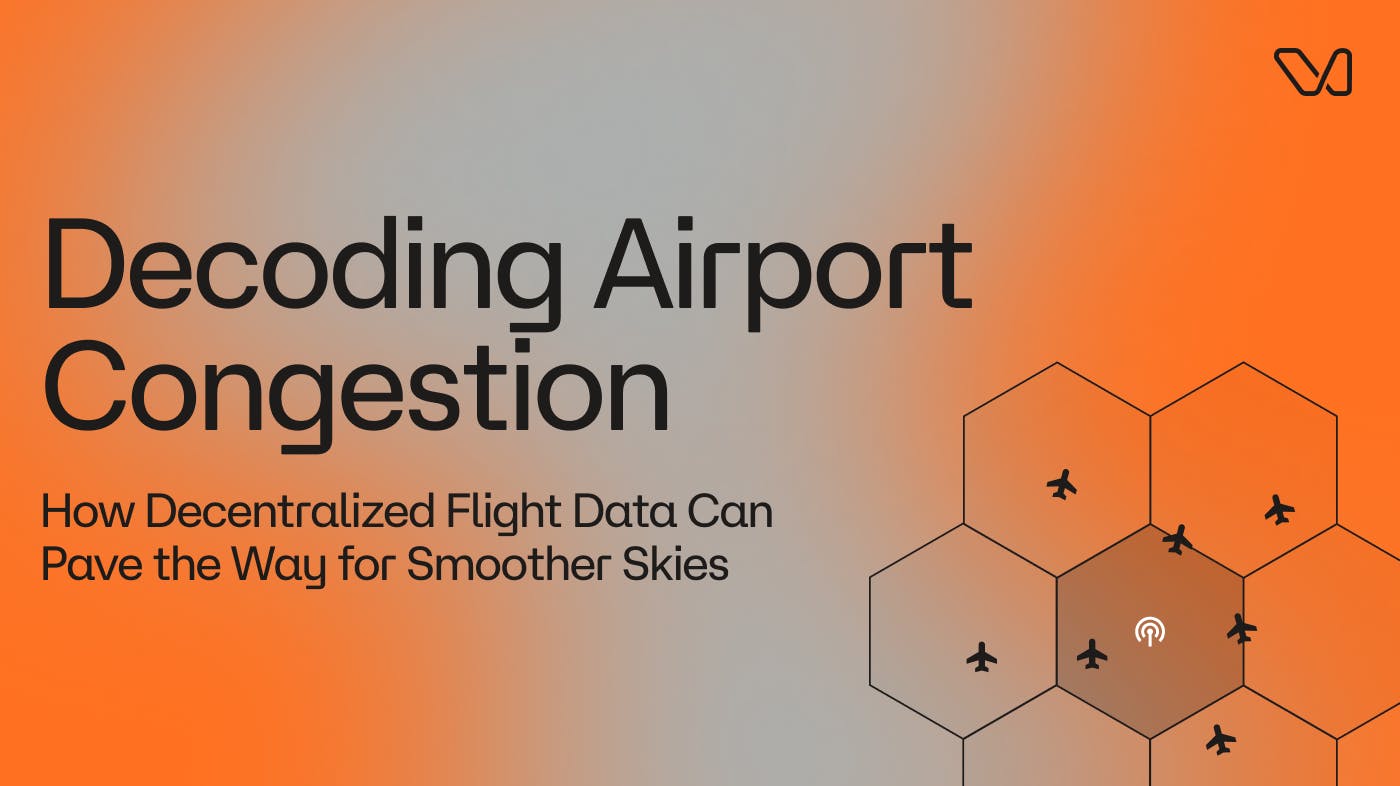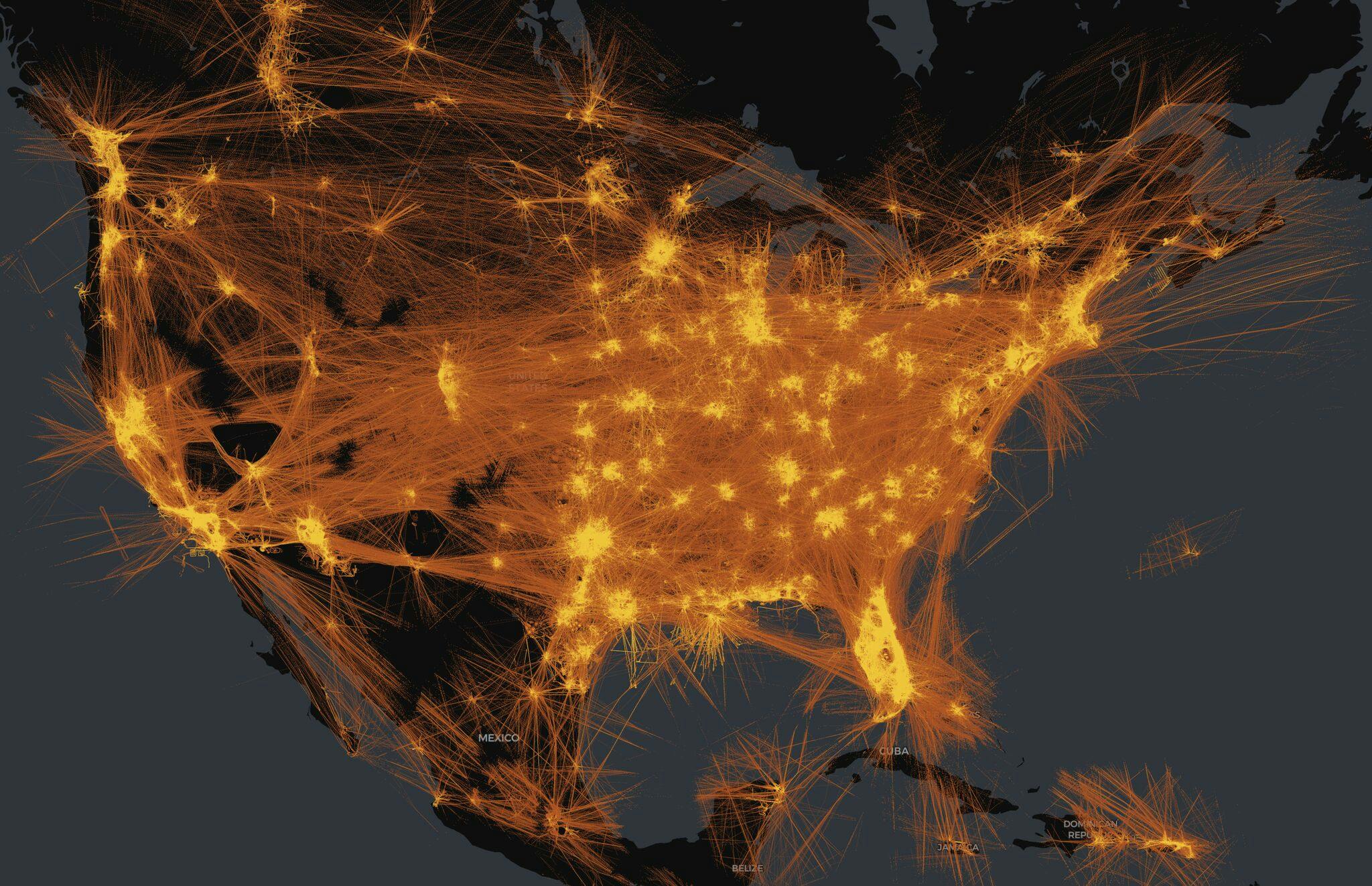Decoding Airport Congestion: How Decentralized Flight Data Can Pave the Way for Smoother Skies
Wingbits
May 26, ‘25

Decoding Airport Congestion: How Decentralized Flight Data Can Pave the Way for Smoother Skies
When a major airport’s radar and radio go dark for just 90 seconds, it’s more than a simple interruption, it’s a stark reminder of how fragile our airspace systems can be. On April 28, 2025, Newark Liberty International Airport lost both radar and radio communications due to a wiring failure. In less than two minutes, operations spiraled: over 200 flights delayed, 110 cancellations by midday, and a ripple effect that reached far beyond New Jersey. Controllers, already stretched thin, faced the consequences of outdated infrastructure and chronic staff shortages. Unfortunately, this wasn’t a fluke, it’s emblematic of deeper issues plaguing the aviation sector.

Portugal Power Outage, 28 April 2025
Understanding the Roots of Airport Congestion: Data Gaps and Systemic Challenges
Air traffic management (ATM) is the nervous system of global aviation, yet right now, it’s frayed at the edges. In the New York City region, only 65% of needed certified controllers are actively working. The training process is lengthy, three to four years on average, and with a 40% dropout rate, bottlenecks are inevitable. Age-related retirements and hiring gaps further strain already limited resources. The result? Persistent delays and a system teetering on the brink, where even a minor hardware failure can unleash chaos.
But it’s not just a people problem. When critical data streams fail, whether due to a faulty wire or a software glitch, airports can grind to a halt. Each minute lost ripples outward, affecting airlines, travelers, and the global economy. As a team of aviation data enthusiasts at Wingbits, we’ve watched how a single point of failure can send shockwaves across continents. Ever wondered what really happens when the radar goes dark at a busy airport? The short answer: widespread, unpredictable disruption.
It’s also important to ask: why does this keep happening in a segment of the aviation industry that is concerned with safety? The answer lies in a mix of aging systems, fragmented upgrades, and a reliance on fragile data pipelines, many of which haven’t changed much in decades. These vulnerabilities are not just technical; they’re deeply systemic.
The Hidden Costs of Data Inconsistency
Incomplete or tampered flight data isn’t just a technical footnote, it can derail runway scheduling, delay emergency responses, and erode trust in the entire system. Let’s be clear: even breakthrough technology can’t wave a magic wand over entrenched issues. Deep structural factors, like regulatory inertia and slow-moving hiring processes, demand time and cooperation to resolve. One of the more important pain point needs to be highlighted: unreliable flight data is a solvable problem, and new approaches are emerging to tackle it head on. The real question is whether the industry is ready to embrace them.
The Decentralization Shift: Why Community-Powered Flight Data Matters
Community-driven flight tracking isn’t a new phenomenon. Platforms like Flightradar24 and OpenSky Network have shown how passionate hobbyists can crowdsource global networks. Flightradar24, for example, distributed free ADS-B receivers and rewarded participation with premium features.
As a group of enthusiasts who have tracked flights for years, there’s an undeniable thrill in catching a rare aircraft or collaborating with others to troubleshoot coverage gaps. The camaraderie and curiosity are real. But here’s the catch: what if every sighting, every data point you contributed, wasn’t just an act of passion but was also rewarded directly? What if your hobby could help power safer, more efficient skies, and earn you rewards in the process?
Volunteer models foster community and engagement, but they often hit a ceiling on sustainability and precision. Without tangible incentives, coverage remains patchy and contributors can burn out. While grassroots networks have laid the groundwork, the next step is building on that foundation to create a system that’s both inclusive and robust.

24h of US traffic captured by Wingbits
The Promise of Decentralized, Reward-Based Models
This is where the Wingbits approach comes in, making the leap from goodwill to real-world impact. By introducing a $WINGS token reward system for contributors who deliver verified, tamper-proof flight data, Wingbits isn’t just bridging gaps left by volunteer-only platforms, it’s changing the incentive structure entirely. Fair rewards mean more reliable, consistent participation. And because participation is tied to tangible benefits, global coverage improves organically and rapidly.
Incentivized contributions reduce patchy data and raise system reliability
Every data point is cryptographically signed, proving location and authenticity
Community involvement accelerates innovation and problem-solving
Instead of relying on volunteers’ spare time and goodwill, Wingbits flips the narrative: contributors are recognized not just with social kudos, but with real, tradable value. Contributors are now rewarded with $WINGS tokens for delivering verified, cryptographically signed flight data. This isn’t just a technical upgrade, it’s a fundamental shift in how aviation data networks can grow, adapt, and deliver value.
Why does this matter for congestion? Because better data powers smarter decisions, whether that’s rerouting planes during a storm or optimizing runway usage minute by minute. With a truly global, incentivized network, gaps shrink, blind spots can slowly disappear, and everyone, from airlines to researchers, gains a clearer view of the sky.
Wingbits in Action: Solving Congestion and Enabling Smarter Airspace Management
So, how does Wingbits actually make a dent in airport congestion? It starts with our specialized DePIN hardware, Wingbits Stations, equipped with millimeter-precise, proof-of-location GPS. This isn’t just “another sensor on the map.” Our H3 hexagon-based coverage system can direct network growth to underserved airspaces, ensuring every corner of the sky above land can be mapped and monitored.
But it goes deeper than just collecting data points. By merging Wingbits’ live position data with real-time weather, predictive congestion analytics and smarter runway scheduling could be achieved. This empowers airports, air traffic managers and flight dispatch teams to act proactively, not reactively, a subtle but powerful shift.
The appetite for actionable, resilient flight data is growing, organizations want not just numbers, but context and insight.
Consider the FAA’s Alaska Aviation Center. By integrating decentralized weather cameras and observation systems into non-radar environments, they’ve boosted situational awareness and safety. It’s a real-world proof point: decentralized, real-time data isn’t just a cool idea, it’s already driving better outcomes in challenging environments.
Concrete Benefits Across the Aviation Ecosystem
The impact of Wingbits goes far beyond traditional flight tracking. Airlines, airport authorities, logistics companies, environmental researchers, and even defense agencies can leverage our data for a range of high-value applications:
Traffic analysis: More accurate modeling of airspace flow and routing decisions for air traffic management solutions companies
Surface surveillance: Live data supports optimal slot allocation, reducing costly delays and congestion
Congestion forecasting: Early warnings allow for proactive planning instead of last-minute chaos
Environmental monitoring: Real-time emissions and carbon tracking, supporting ESG reporting and compliance
UAV oversight: Reliable tracking for drones and low-altitude flights, essential for future airspace integration
Insurance validation: Verifiable, live data streamlines claims and risk assessment
Threat detection: Immediate alerts for unauthorized or suspicious activity in controlled airspace
Commodities trading: Real-time insights into supply chain disruptions and market moves
Imagine if every airport, not just the busy hubs in New York or London, could access the same high-grade, real-time ADS-B data. That would mean fewer unexpected disruptions, smarter planning, and a more resilient aviation industry worldwide. Of course, connecting decentralized systems with legacy infrastructure isn’t as easy as flipping a switch. It takes technical know-how, regulatory coordination, and a willingness to experiment. But the momentum is real, and the results are already coming into view.
For researchers and academics, this shift means unprecedented access to historical and live flight data, fueling new discoveries in everything from airspace optimization to climate science. In short: decentralized flight tracking isn’t just about technology. It’s about opening new possibilities for every stakeholder in the sky.

1h of Newark Airport Data, 14 April 2025, captured by Wingbits
Building the Future: Resilience, Transparency, and Community Ownership
At Wingbits, we believe sustainability shouldn’t just be a marketing buzzword, so we’ve embedded it in our network’s DNA. As our global coverage expands and key milestones are reached, we monetize the data and recycle revenue back to the contributors. This isn’t a top-down model where a company profits from free labor. Instead, the community that powers the network shares in its growth and financial upside.
The social impact is real and growing. Accurate, decentralized data supports not only safer skies, but smarter carbon tracking and more responsive emergency services. Insurers gain confidence in their pricing, security agencies react faster to threats, and academics explore new research frontiers.
Why does this matter in the long run? Because a resilient, transparent network can adapt to future needs, like drone integration, new regulatory frameworks, or sudden spikes in air traffic. Community-powered infrastructure isn’t just fairer; it’s also more robust, future-ready, and genuinely inclusive.
The Path Ahead, Opportunities and Challenges
Let’s be real: the journey toward decentralized flight tracking isn’t a straight line. Regulatory hurdles, complex integrations, and onboarding new users all take time and collaboration. But the wave of support from the U.S. Department of Transportation, the FAA, airlines, and B2B partners is unmistakable. Major investments are flowing into modernization and real-time data networks, signaling that the industry is hungry for disruption.
Building the world’s most accurate map of the sky isn’t just a tech challenge, it’s a community mission. At Wingbits, we’re explorers at heart, energized by the chance to push boundaries and empower others to do the same.
Ready to Power the Future of Aviation?
Explore our data, view live flight activity, and discover how you can leverage the datasets to achieve your business objectives. Whether you’re an airport authority, airline, researcher, or aviation enthusiast, Wingbits has a place for you. Learn more about how decentralized flight tracking can transform your operations today.
FAQ
What makes Wingbits’ flight data better for airport congestion management?
Decentralized networks like Wingbits provide real-time, cryptographically secure, ADS-B data, reducing the likelihood of patchy coverage. This resilience enables more accurate traffic forecasting, responsive surface surveillance, and safer, more efficient airspace management.
Can Wingbits data help with low-altitude drone and UAV tracking?
Yes. Wingbits’ network supports surveillance of low-altitude flights, enabling safer drone operations and regulatory oversight. This is crucial for logistics, emergency response, and future eVTOL services.
Who uses Wingbits data, and for what applications?
Airlines, airport authorities, logistics firms, defense agencies, environmental researchers, insurers, data engineers focused on ML/AI applications and travel platforms use Wingbits’ ADS-B data for everything from congestion forecasting and threat detection to insurance validation and carbon emissions tracking. Find out more.
How does Wingbits ensure data quality and security?
Wingbits uses cryptographically signed data, millimeter-level GPS proof-of-location, and a reward structure that incentivizes uptime and accuracy. This guarantees that ADS-B data is trustworthy, traceable, and reliable.

Company
Wingbits is a DePIN (Decentralized Physical Infrastructure Network) that rewards community members with $WINGS tokens for monitoring aircraft in real-time using specialized ADS-B hardware. The network aligns incentives to compensate participants based on the quality and quantity of flight tracking data they contribute, creating a more equitable alternative to traditional tracking systems. By incentivizing strategic hardware placement and reliable uptime, Wingbits is building the world's largest and most secure flight tracking network while disrupting an industry that has relied on unpaid volunteers for decades.
